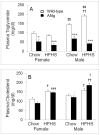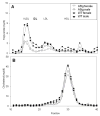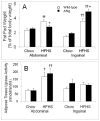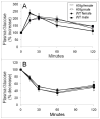Overexpression of apolipoprotein A5 in mice is not protective against body weight gain and aberrant glucose homeostasis
- PMID: 19303979
- PMCID: PMC2689095
- DOI: 10.1016/j.metabol.2008.11.018
Overexpression of apolipoprotein A5 in mice is not protective against body weight gain and aberrant glucose homeostasis
Abstract
Apolipoprotein A5 (APOA5) is expressed primarily in the liver and modulates plasma triglyceride levels in mice and humans. Mice overexpressing APOA5 exhibit reduced plasma triglyceride levels. Because there is a tight association between plasma triglyceride concentration and traits of the metabolic syndrome, we used transgenic mice overexpressing human APOA5 to test the concept that these mice would be protected from diet-induced obesity and insulin resistance. Male and female transgenic and wild-type mice on the FVB/N genetic background were fed standard rodent chow or a diet rich in fat and sucrose for 18 weeks, during which time clinical phenotypes associated with obesity and glucose homeostasis were measured. We found that APOA5 transgenic (A5tg) mice were resistant to diet-induced changes in plasma triglyceride but not total cholesterol levels. Body weights were similar between the genotypes for females and males, although male A5tg mice showed a modest but significant increase in the relative size of inguinal fat pads. Although male A5tg mice showed a significantly increased ratio of plasma glucose to insulin, profiles of glucose clearance as evaluated after injections of glucose or insulin failed to reveal any differences between genotypes. Overall, our data showed that there was no advantage to responses to diet-induced obesity with chronic reduction of plasma triglyceride levels as mediated by overexpression of APOA5.
Figures




Similar articles
-
Apolipoprotein A5 deficiency aggravates high-fat diet-induced obesity due to impaired central regulation of food intake.FASEB J. 2013 Aug;27(8):3354-62. doi: 10.1096/fj.12-225367. Epub 2013 May 6. FASEB J. 2013. PMID: 23650188
-
Apolipoprotein A5 controls fructose-induced metabolic dysregulation in mice.Nutr Metab Cardiovasc Dis. 2021 Mar 10;31(3):972-978. doi: 10.1016/j.numecd.2020.11.008. Epub 2020 Nov 17. Nutr Metab Cardiovasc Dis. 2021. PMID: 33549451
-
Decreased apolipoprotein A5 is implicated in insulin resistance-related hypertriglyceridemia in obesity.Atherosclerosis. 2010 Jun;210(2):563-8. doi: 10.1016/j.atherosclerosis.2009.12.004. Epub 2009 Dec 11. Atherosclerosis. 2010. PMID: 20047745
-
Apolipoprotein A5, a newly identified gene that affects plasma triglyceride levels in humans and mice.Arterioscler Thromb Vasc Biol. 2003 Apr 1;23(4):529-34. doi: 10.1161/01.ATV.0000054194.78240.45. Epub 2002 Dec 26. Arterioscler Thromb Vasc Biol. 2003. PMID: 12615678 Review.
-
Is apolipoprotein A5 a novel regulator of triglyceride-rich lipoproteins?Ann Med. 2006;38(1):2-10. doi: 10.1080/07853890500407488. Ann Med. 2006. PMID: 16448983 Review.
Cited by
-
Macrophage metalloelastase (MMP12) regulates adipose tissue expansion, insulin sensitivity, and expression of inducible nitric oxide synthase.Endocrinology. 2014 Sep;155(9):3409-20. doi: 10.1210/en.2014-1037. Epub 2014 Jun 10. Endocrinology. 2014. PMID: 24914938 Free PMC article.
-
The paradox of ApoA5 modulation of triglycerides: evidence from clinical and basic research.Clin Biochem. 2013 Jan;46(1-2):12-9. doi: 10.1016/j.clinbiochem.2012.09.007. Epub 2012 Sep 19. Clin Biochem. 2013. PMID: 23000317 Free PMC article. Review.
-
Influence of apolipoprotein A-V on hepatocyte lipid droplet formation.Biochem Biophys Res Commun. 2012 Oct 19;427(2):361-5. doi: 10.1016/j.bbrc.2012.09.065. Epub 2012 Sep 18. Biochem Biophys Res Commun. 2012. PMID: 23000161 Free PMC article.
-
Receptors for tumor necrosis factor-alpha play a protective role against obesity and alter adipose tissue macrophage status.Endocrinology. 2009 Sep;150(9):4124-34. doi: 10.1210/en.2009-0137. Epub 2009 May 28. Endocrinology. 2009. PMID: 19477937 Free PMC article.
-
Biogenesis of apolipoprotein A-V and its impact on VLDL triglyceride secretion.J Lipid Res. 2011 Feb;52(2):237-44. doi: 10.1194/jlr.M010793. Epub 2010 Nov 26. J Lipid Res. 2011. PMID: 21115968 Free PMC article.
References
-
- Austin MA, Hokanson JE, Edwards KL. Hypertriglyceridemia as a cardiovascular risk factor. American Journal Cardiology. 1998;81:7B–12B. - PubMed
-
- Brunzell JD, Ayyobi AF. Dyslipidemia in the metabolic syndrome and type 2 diabetes mellitus. American Journal Medicine. 2003;115(Suppl 8A):24S–28S. - PubMed
-
- Fujimoto WY. The importance of insulin resistance in the pathogenesis of type 2 diabetes mellitus. American Journal Medicine. 2000;108(Suppl 6a):9S–14S. - PubMed
-
- Hedley AA, Ogden CL, Johnson CL, Carroll MD, Curtin LR, Flegal KM. Prevalence of overweight and obesity among US children, adolescents, and adults, 1999–2002. Journal of the American Medical Association. 2004;291:2847–2850. - PubMed
-
- Fruchart JC, Nierman MC, Stroes ES, Kastelein JJ, Duriez P. New risk factors for atherosclerosis and patient risk assessment. Circulation. 2004;109:III15–19. - PubMed
Publication types
MeSH terms
Substances
Grants and funding
LinkOut - more resources
Full Text Sources
Other Literature Sources
Medical
Miscellaneous

